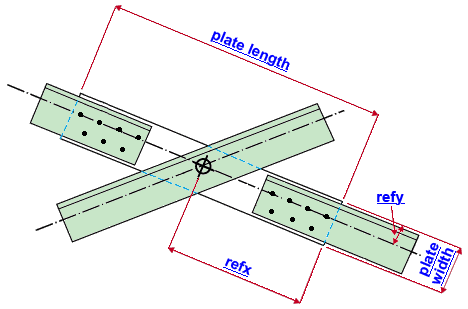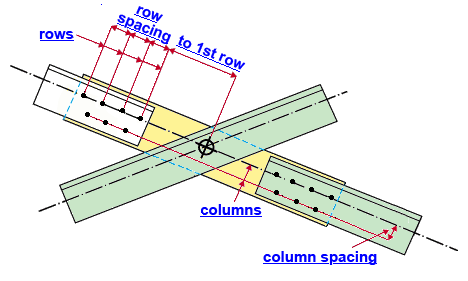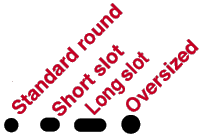"  Gusset Intersection " & "
Gusset Intersection " & "  Brace Connection To Gusset " connection design locks
Brace Connection To Gusset " connection design locks
| An angle vertical brace intersection plate is designed per " |
| " (intersection plate dimensions and location)  |
" (hole pattern for field bolting braces to intersection plate)  |
Connection Guide: Click here or here for related screen shots.
End connection failure message: Braces must be colinear .
End connection failure message: Both braces must be either on/off the neutral axis .
End connection failure message: Both braces must have the same material type .User Defined Connections: Settings that are locked (
) in the user defined connection file will automatically be locked on the member edit window. You can, if you so choose, manually lock additional settings on the member edit window, and your changes will be retained, through multiple processes, so long as you do not change to a different connection then switch back to the original user defined connection.
Vertical Brace Edit: To change a setting, first set it to locked (
). Related settings that are unlocked (
) may be updated, and the "
Left/Right end limit state " calculations will be updated. Settings that are locked (
) will not be changed by connection design , even if doing so might prevent a connection failure.
Connection design locks :
| Locks not dimensioned or called out on the drawing are marked ( not depicted ). |
![]() Gusset Intersection
Gusset Intersection
(L, WT, C, double-L)
Gusset Intersection
Thickness ( not depicted ): The " Material thickness " of the intersection plate material.
Width ( plate width ): The distance (perpendicular to the work lines of the supported braces) between the two edges of the intersection plate that are parallel with each of the work lines of the supported braces (see example ). In other words, this is the length of either of the two shorter edges of the intersection plate. Increasing the intersection plate " Width " on both of the supported braces adds material down, toward lower elevations. Tip : The intersection plate " Width " is symmetrical around the work lines of the two supported braces if the " Refx " is half the distance entered here.
Length ( plate length ): The distance parallel with the work lines of the supported (supported) braces between the two edges of the intersection plate that are perpendicular to the supported braces' work lines (see example ). In other words, this is the length of either of the two long edges of the intersection plate. Increasing the intersection plate " Length " on both of the supported braces adds material to the end of the plate associated with the left brace. Tip : The intersection plate " Length " is symmetrical around the work point shared by the two supported braces if the " Refx " is half the distance entered here.
Refx: The distance (parallel to the work line of the supported brace) from the work point to the edge of the intersection plate that the right vertical brace frames to (see example ). Increasing the " Refx " on both of the supported braces shifts the center of the intersection plate toward the right brace.
Refy: The distance (perpendicular to the work line of either of the supported braces) from the work point to the upper longer edge of the intersection plate (see example ). Increasing the " Refy " on both of the supported braces shifts the intersection plate upward in a direction perpendicular to the work lines of the supported braces.
![]() Brace Connection To Gusset
Brace Connection To Gusset
(L, WT, C, double-L)
Brace Connection To Gusset
Bolt diameter ( not depicted ): You can either type in any diameter (inches or mm), or you can select a bolt diameter from the combo box (
). The diameters that are listed in the combo box come from Home > Project Settings > Job > Bolt Settings > the " Available bolt diameters " list. The bolt diameter entered here, along with the " Hole type " entered below, together set the diameter of the holes the bolts goes into. The two braces that bolt to the intersection plate can have different bolt diameters.
Hole type ( not depicted ): Standard round or Short slot or Oversized or Long slot or User slot #1 or User slot #2 . This is the hole type for all bolts on the vertical brace intersection plate. If you enter a different " Hole type " for each of the two supported (shorter) vertical braces, connection design uses the hole type entered for the left brace.

Detailing : A vertical brace intersection plate shop bolts to the supporting brace (usually the longer brace) and therefore appears as a submaterial on the detail for that brace. The intersection plate field bolts to the two supported braces.
Rows: The total number of holes in the column of holes with the greatest number of holes. Bolt rows on a vertical brace intersection plate run perpendicular to the work lines of the two supported vertical braces (see example ). For the angle brace in the example above, the number of " Rows " is ' 4 '.
Distance to 1st hole along brace ( to 1st hole ): The distance (parallel with the work line of the supported vertical brace you are editing) from the work point to the first row of holes on the half of the intersection plate you are editing (see example ).
Hole spacing along brace ( row spacing ): The distance (center to center) between of any two adjacent holes in the same column of holes (see example ).
End connection failure message: Invalid bolt spacing
Columns: The number of columns of holes for bolting either of the supported (shorter) braces to the intersection plate. In the example above, this number is ' 2 '.
Hole spacing perpendicular to brace ( column spacing ): The distance (center to center) between columns of holes (see example ). An entry of ' 0 ' is appropriate when there is only a single column of bolts.







